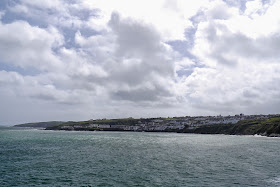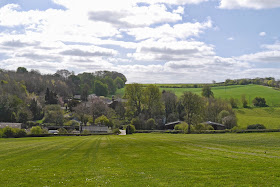Today we continued walking the Stour Valley Path, picking up the
route at Bryanston Village. The first challenge
to find our way through Bryanston School. It did offer a nice view back over the village (above).
We also had a good view of
the house which was the basis of the school when it was founded in 1928.
Richard Norman Shaw built the house in the 1890s for the 2nd Viscount Portman.
Having eventually found our way out of the school - why were there no
signs? - we followed the road to the village of Durweston, with the
Stour on our right.
The rape field on the left created a dramatic block of colour, contrasting with the bright blue sky.
As we entered the village we saw this old station sign by the local school.
We crossed the A357 and headed towards Stourpaine, passing a rather
unexciting mill and under a railway bridge. The defunct line is now a
"Trailway".
The church at Stourpaine was quite picturesque: the tower is old, but the rest was by T H Wyatt (whose work we saw yesterday at
Spetisbury). The deceptively gentle curve of Hod Hill can be seen in the background.
Walking along the main street of this interesting village, we were very
taken by this formal garden on the left hand side. The gate was open, but
there was no sign and we were unsure whether it was a public or private space.
Soon we began the ascent of Hod Hill, eschewing the option to make a circuit if its base. On the way up, I saw my first Speckled Wood of the year. The poor thing is lacking an antenna.
Hod Hill was the site of an iron age hill fort and the defensive ditch is still very prominent. It was also covered in the Cowslips can that be seen in the foreground. I was surprised to see a Kite in the sky above. They are now extremely common in the Thames Valley, but I can't recall seeing one in Dorset before.
As you approach the top (143m) of this wide almost flat hill, there are
views all around: it is almost a 360 degree panorama. This is the view to the north east.
You can't however
see past Hambledon Hill straight ahead.
We descended Hod Hill by the main path, crossed the road and climbed up a
steep slope to join a ridge, appropriately enough part of the Wessex
Ridgeway. There was a good view north towards Iwerne Minster, with
Canford Chase further to the east.
We followed the ridge onto Hambledon Hill itself. It too was the site of a iron age hill fort: were they allies of Hod Hill or rivals? We climbed the tiny
pimple which is at 193m its highest point and continued along to the end. It
appears to be a cliff edge as you approach, but reveals a sort of lower
terrace. When you get down to this, there is another one.
There is a great view down towards the drive of trees which leads to the Manor House of Child Okeford.
Having found a lateral way down, we followed a path then a road into
the centre of Child Okeford, where we had refreshments at the village
pub before carrying on our way westwards. This
led us across fields which offered a view back towards Hambledon Hill, the pimple of the summit could be clearly seen, as could the stages of our descent.
We rejoined the river Stour briefly, crossing over a concrete bridge. It must be
admitted that at this point in its life it is not an especially
attractive river. We picked up a track heading north and at Ham Hill natural burial ground were diverted onto the route of a railway line which once went all the way to Wincanton. We followed this until we met a road where a right turn led us finally to Hammoon.
Hammoon is a tiny hamlet, but boasts a nice little 12th or 13th century church (St Paul), with a Victorian wooden belfry.
There is also a surprising thatched manor house, much altered over its life. Pevsner dates the bay on the right to the early 16th century and the porch to about 1600. The entrance doorway may be later.
Butterflies
I have decided to add interest to my butterfly spotting this year by noting when I first see each species. Today we saw Peacock, Small Tortoisehell, Small White, Comma, Speckled Wood, Orange Tip, Brimstone. The Comma was also the first of the year.
Conditions: warm and sunny.
Distance: 7.25 miles. Total now covered almost 40 miles - two-thirds of the way.
Guide: The new Stour Valley Path by Edward R Griffiths, Greenfield Books, 1998, but sadly out of print
Map: Explorer 117 (Cerne Abbas & Bere Regis), 118 (Shaftesbury and Cranfield Chase) and 129 (Yeovil & Sherborne)
Rating: four and a half stars. Full of variety and interest. The two hills were a revelation. Much more dramatic than any previous part of this walk.





























































